If you are a novice pet owner, it can be a little confusing to get your guinea pig the right feeds. Guinea pigs are pure herbivores, so they strictly feed on plant matter only, such as hay and leafy vegetables.
Before you go out looking for feeds for your cavy, there are a few essentials you should consider when choosing the right feed.
First, guinea pigs have constantly growing teeth, so they need feeds with high roughage content to constantly wear their teeth down.
Guinea pigs cannot also form their own vitamin C, so you have to supplement the possible deficiency with foods rich in vitamin C like fruits and vegetables, lest you risk your guinea pig contracting scurvy.
Guinea pigs also have very delicate tummies and can only handle dry feeds, although they occasionally need water, so do not overfeed fruits and fresh vegetables.
Now that we know what to consider when buying feeds, what do guinea pigs eat?
Read on for a comprehensive guide on what guinea pigs eat and how they benefit the animal.

Table of Contents
What Can Guinea Pigs Eat?
1. Grass Hay/Grass
Guinea pigs should have constant access to grass hay. Hay has the right nutritional needs for guinea pigs.
Guinea pigs should have an 80% hay diet and the remaining 20% be of occasional treats and pellets.
However, not all hay is appropriate for guinea pigs. Timothy, barley, grass, and oat hay are all good staples.
Clover and alfalfa hay, on the other hand, should not be fed regularly because of their high levels of calcium and protein. These two can, however, be fed to young guinea pigs below six months to help them in the crucial growth and development stages.
Furthermore, hay has a high roughage content which encourages the guinea pig to chew for longer periods, subsequently aiding in the wearing of their ever-growing teeth. This helps keep the teeth in shape, hence avoiding dental problems with your pet or any gastrointestinal disorder.
Guinea pigs need hay in large amounts, almost half their body weight on a daily basis to maintain a healthy gut. This means that you should not give it in portions, but simply avail it in bulk and let them eat as they will.
Make the hay available all around the clock in their racks and baskets, fresh and away from any dirt or droppings that would contaminate the hay and maybe get it wet, moldy, smelly, or attract fungi. Your guinea pig can get sick if it eats from such an unhygienic environment.
2. Clean water
Guinea pigs should have a constant supply of clean drinking water. Although they might not need it regularly, they should access it whenever they want.
You can avail the water in either of the two ways: a water bottle or a bowl.
However, a water bottle is recommended because guinea pigs run a lot in and out of their shelters, and are likely to kick their droppings into a water bowl. A water bottle, on the other hand, protects the water from such incidents while maintaining availability.

3. Pellets
Pellets are a good supplement for essential nutrients for your guinea pig. However, you must ensure to purchase pellets made specifically for guinea pigs, all-natural and hay-based. Pellets with added preservatives and artificial synthetics may be toxic and may cause harm to your pet guinea pig.
Can Guinea Pigs Eat Fruits?
Yes, guinea pigs can eat fruits, but only as occasional treats.
Since they are high in sugar and water, fruits can cause gut problems like diarrhea or other advanced health problems like obesity if fed in excess. Therefore, feed them only a slice or two of the fruit at most.
So which fruits can guinea pigs eat?
1. Watermelon
Either the flesh or the rind of the melon is good for your guinea pig. However, only feed them a slice or two a week.
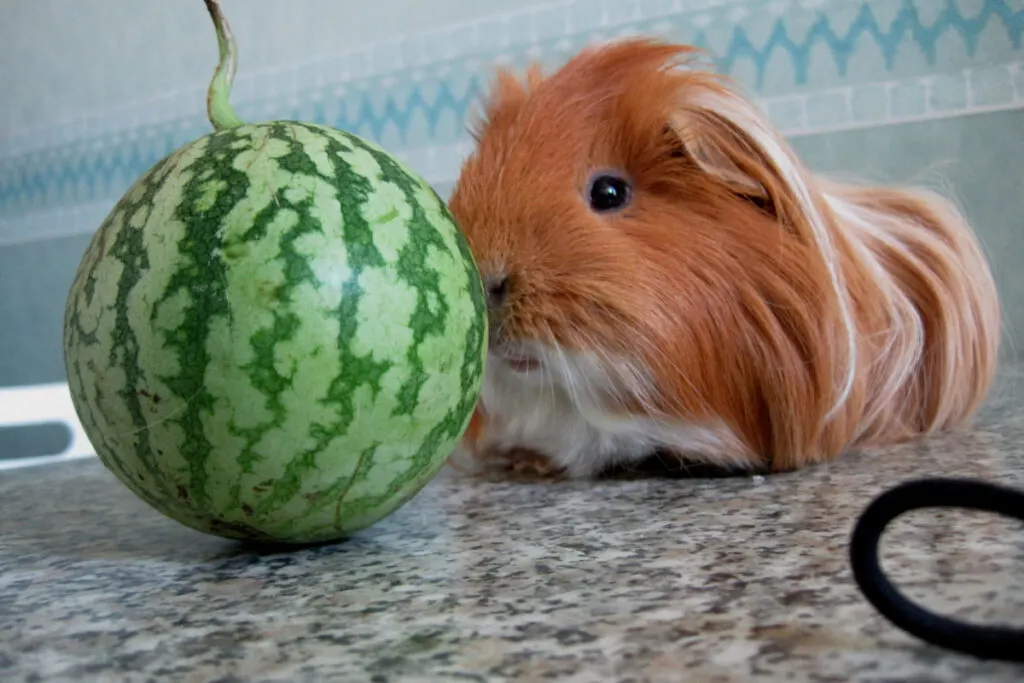
2. Bananas
Bananas are good sources of essential nutrients and vitamins like fiber, vitamin A, vitamin C, and vitamin B-6 which specifically help to maintain the skin health of your guinea pig and its fur.
3. Apple
Both the apple flesh and peels are good for your guinea pig. The peels are rich in fiber which helps maintain good gut health.
They also like apple leaves and branches, which helps them wear down their teeth as they chew besides being a good source of calcium.
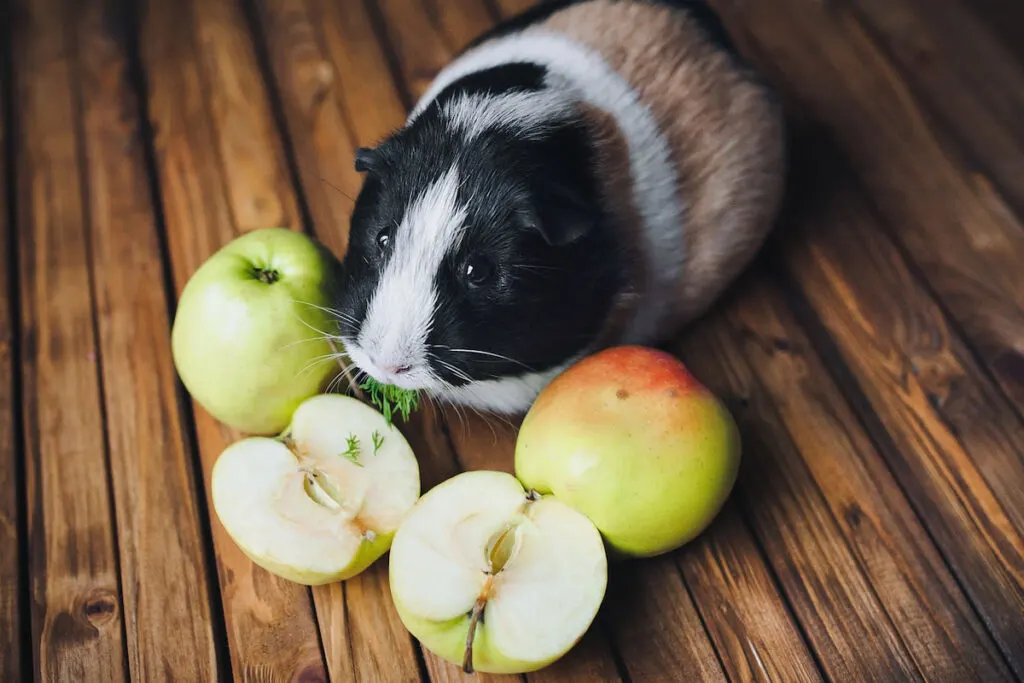
4. Blueberry
Although blueberries are rich in essential vitamins and antioxidants for your guinea pig, they are too sugary and acidic. For this reason, blueberries should be fed in small amounts.
Some guinea pigs might also be allergic to blueberries and develop sores in their mouths, so you need to gradually introduce them and observe the guinea pig’s reaction.
5. Cantaloupe
Although they may be too sugary, cantaloupes are a good source of vitamin C for your guinea pig.
Therefore, only serve them not more than twice a week in small quantities. Cantaloupe seeds are also big and guinea pigs have small throats, so remove any seeds to avoid choking them.
Can Guinea Pigs Eat Fresh Vegetables?
Yes, guinea pigs can eat a wide range of fresh vegetables and herbs.
Vegetables are a good source of vitamin C among other essential nutrients needed by guinea pigs.
However, try as much as possible to alternate the kind of vegetables you offer your guinea pig to avoid only providing a select few nutrients, but rather a wider range of nutrients for better health.
So which vegetables can guinea pigs eat?
1. Carrots
Although your cavies might love carrots, they are especially high in sugar, so they should be fed moderately. Their green tops are also good for your guinea pig but are high in calcium, so they should be offered sparingly, most preferably once a week.

2. Kale
Although kales are nutrient-packed, they have high water content and contain too much calcium for a daily feed for your pet. Too much water can cause diarrhea and vomiting, so you will need to offer it at most once a week.
3. Asparagus
Asparagus is packed with plenty of nutrients and has a low sugar content, making it the ideal vegetable for your guinea pig.
Although it is unlikely to cause any belly disorders or health problems, you should only feed your guinea pigs chopped asparagus up to 3 or 4 times a week.
4. Cabbage
Both green and red cabbage are nutrient-packed, making cabbage a good vegetable for your guinea pig.
However, they both have high water content and can cause digestive problems for some pets. This, therefore, prompts you to gradually introduce cabbage in small amounts and watch how the guinea pig reacts.
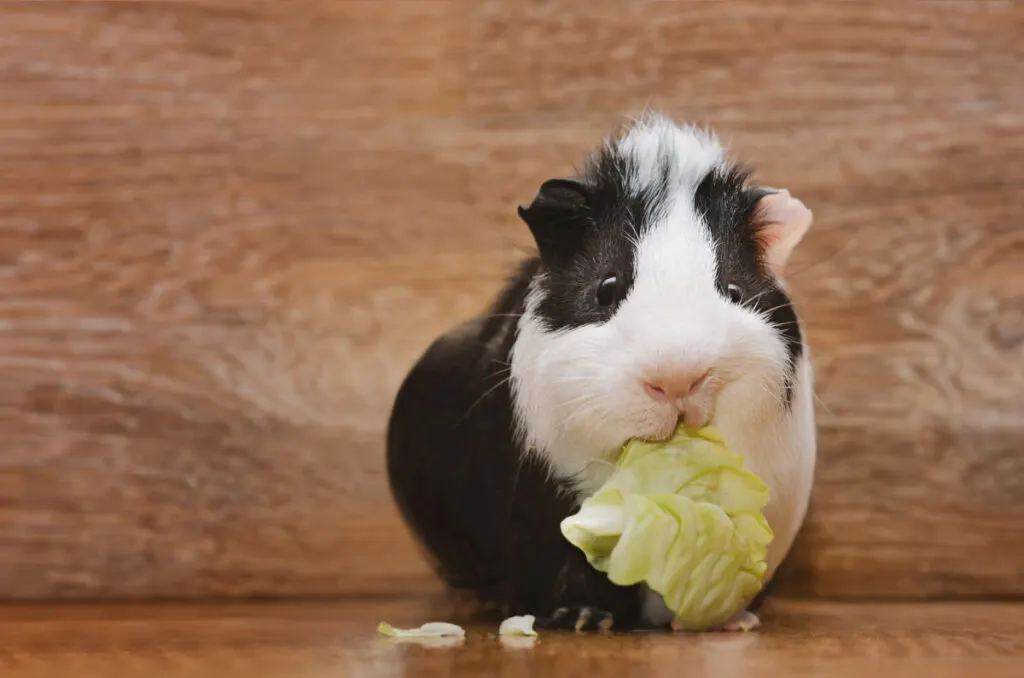
5. Celery
Celery is a rich source of vitamin C for your pet. However, you should not feed any more than ¼ of the stalk with the leaves to avoid possible diarrhea and high calcium levels. For this, feeding with other vegetables once or twice a week is enough.
6. Romaine Lettuce
Romaine lettuce is highly nutritious and healthy for your guinea pigs. Its high fiber content also promotes healthy bowel movements. Therefore, romaine can be offered multiple times a week, provided it is well-washed and chopped into smaller pieces for easy chewing.
7. Broccoli
Broccoli is highly beneficial and safe to give your guinea pig. All the plant parts are healthy for your guinea pig, and a teaspoon can be added to the daily feeds as a mini supplement.
8. Bell Peppers
Bell peppers are low in sugar but are highly packed with essential nutrients like vitamins A and C, making them ideal vegetables for a daily feeding plan. Just make sure to chop them into manageable chunks before offering them to the guinea pig.

9. Collard Greens
Collard greens are good for your guinea pig because they are rich in vital nutrients like vitamins A, C, and K, as well as having blood sugar level balancing properties, thanks to an enzyme it contains called alpha-lipoic acid.
You should, however, limit the feeding capacity to less than a handful every week because of the high water and calcium levels that may lead to diarrhea and other health complications.
10. Basil
Basil is a very healthy treat for your guinea pig because it gives it plenty of vitamin C among other nutrients.
However, you must limit the number of times you feed basil to your guinea pig. Once or twice a week is enough because of the high calcium content that may be problematic if not regulated.
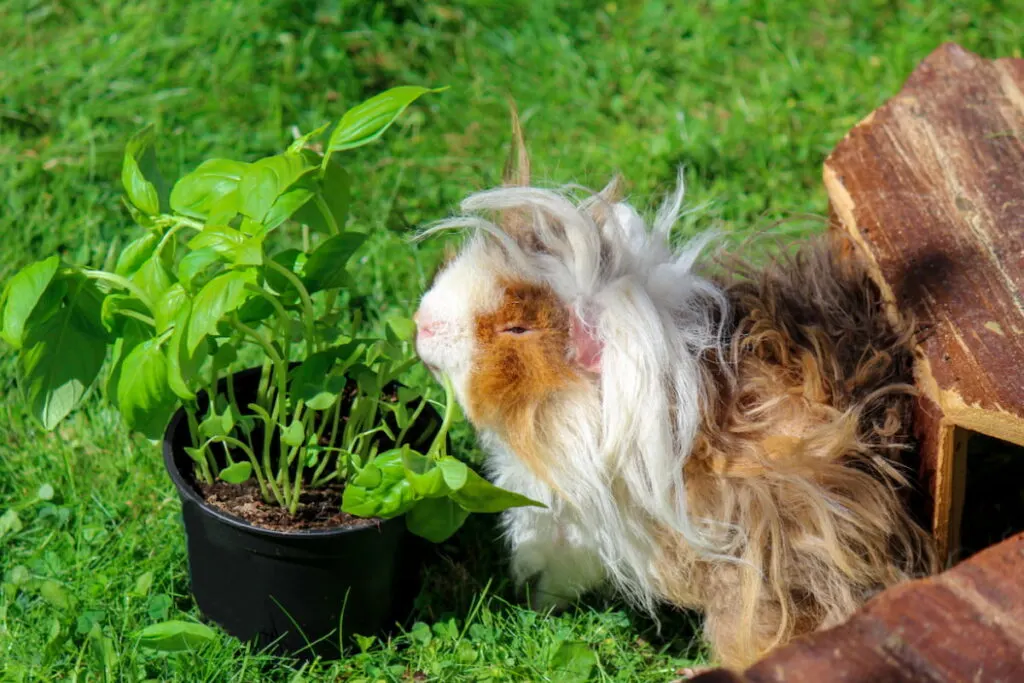
Can Guinea Pigs Eat Frozen Vegetables or Fruits?
No, frozen food is not good for guinea pigs, as well as tinned or canned food. For maximum food safety, only fresh vegetables and fruits are allowed for treats. If you can’t find anything fresh, look around for safe herbs.
Tips on Feeding Fresh Fruits and Veggies
- Fruits should be chopped into fine chunks, and given in small quantities.
- Always wash the fruits and vegetables thoroughly to wash off any dirt and chemicals before giving them to your pet.
- When introducing new feeds, initially offer in small amounts to monitor if there is any development of tummy troubles.
- Since they can be selective to taste, insist on feeds they do not initially like to see their later reaction and abort if they completely dislike it.
- Always vary the fresh feeds for a diverse range of additional nutrients. Just be certain that the feed or treat you are offering is safe for your guinea pig to eat.
- If they quickly eat a safe treat and look around for some more, offer a larger chunk next time, but if they leave a lot of the veggies or the fruit, it means that you are probably overfeeding them. Whenever there are remains in the cage, ensure to remove them promptly.
What Should Guinea Pigs Not Eat?
For several reasons, there are a number of foods that a guinea pig should not eat. Some feeds are toxic and poisonous to the guinea pigs’ digestive system, others are a choking menace, some have high sugar and fat contents, some have no nutritional value, and others cause too much gas and bloat.
These forbidden feeds include:
- meat
- dairy products
- pickled foods
- sugar
- chocolate
- pasta
- biscuits
- crackers
- bread
- seeds and nuts
- cereals
- grains
- corn
- peas
- dried beans
- buttercups
- lilies
- garden shrubs
- avocado
- onions
- garlic
- bok choy
- sweet peas
- onion grass
- mushrooms
- oak
- nightshade
- foxglove
- potato tops
- rhubarb greens
- daffodils.
Whenever you are not sure if a feed is safe for your pet guinea pig, always consult an exotic animal vet for proper guidelines on how to best feed your pet guinea pig.

Is It Normal for Your Guinea Pig to Eat Poop?
It is normal for your guinea pig to eat poop.
In reality, what the guinea pig is eating is not a waste version of poo but rather one that is not entirely digested and needs to be ingested back in a process called coprophagy.
The undigested version (cecotrope) is always of bright color, making it distinct from the dark waste version of poop.
You should, however, get concerned if your guinea pig is not eating its cecotropes.
Make Feeding Fun
Guinea pigs are fun-loving animals who easily get excited at the sight of foods and treats. To make the feeding process interesting, therefore, invent a way to replicate how they would be searching for foods out in the wild.
This can be achieved by hiding treats within their hay for them to forage in and discover. You can also give them their hay in paper bags, and they easily get excited trying to find a way in for their food.
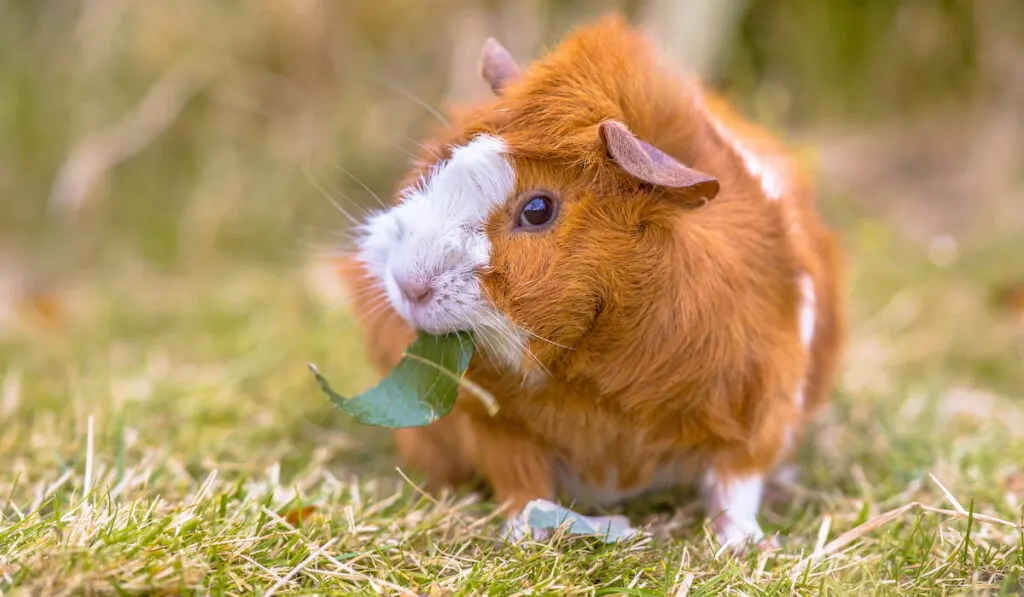
Conclusion
Feeding a guinea pig is quite an easy task if you are familiar with the feeds you are offering your pet. The guide above will help you figure out what feeds are best for your guinea pig. If you are uncertain about a feed, always consult your vet to avoid possible problems. Have fun feeding your guinea pig.
Resources
- https://www.guineapiggles.co.uk/guinea-pig-food-chart/
- https://chowhoundpet.com/the-ultimate-guinea-pig-food-list-what-is-safe/
- https://www.petco.com/content/petco/PetcoStore/en_US/pet-services/resource-center/food-nutrition/guinea-pig-care-diet-and-feeding-tips.html
- https://www.pdsa.org.uk/pet-help-and-advice/looking-after-your-pet/small-pets/your-guinea-pig-s-diet
- https://kb.rspca.org.au/knowledge-base/what-should-i-feed-my-guinea-pigs/
- https://www.humanesociety.org/resources/guinea-pig-feeding
- https://petkeen.com/best-vegetables-for-guinea-pigs/
- https://guineadad.com/blogs/news/best-vegetable-for-guinea-pigs
- https://squeaksandnibbles.com/kind-fruit-can-guinea-pigs-eat/
- https://www.thesprucepets.com/guinea-pigs-diet-4580376
- https://guineadad.com/blogs/news/6-most-popular-fruits-for-guinea-pigs
